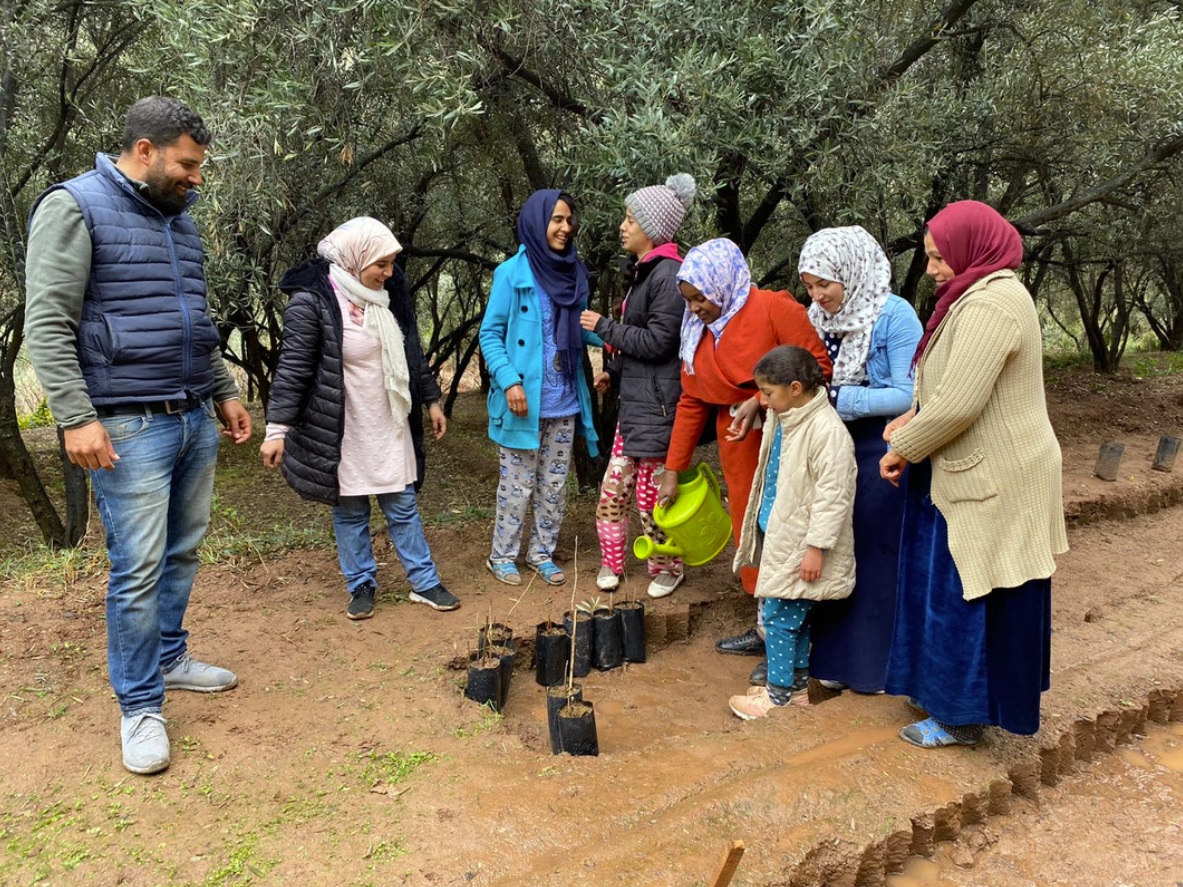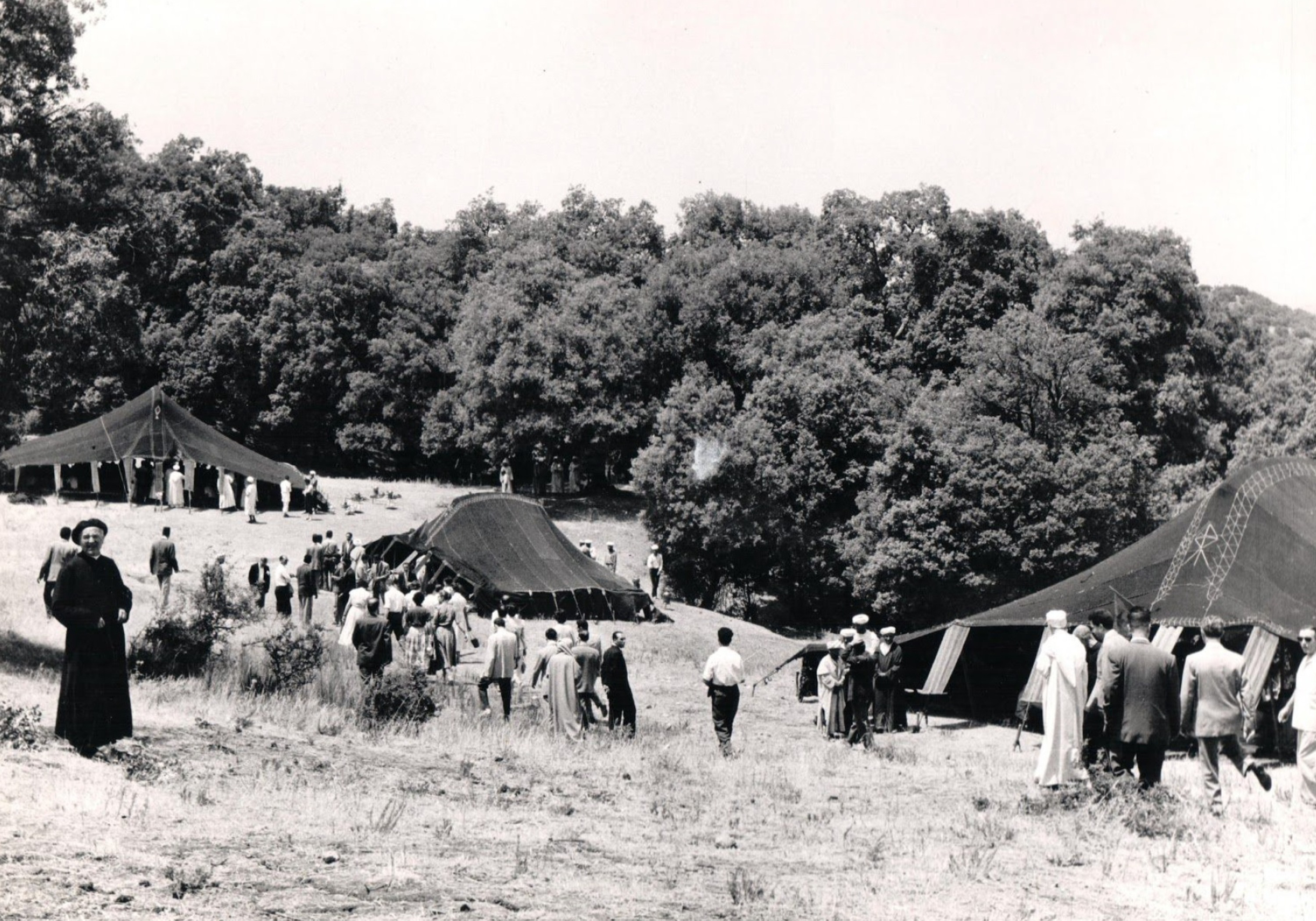
Thesis : An Open Cloister
Spring 2021 | critics: Karen Van Lengen, FAIA + Alexander Yuen 
Construct the Edge | Introduce Architectural Elements | Plan a network of experiential paths
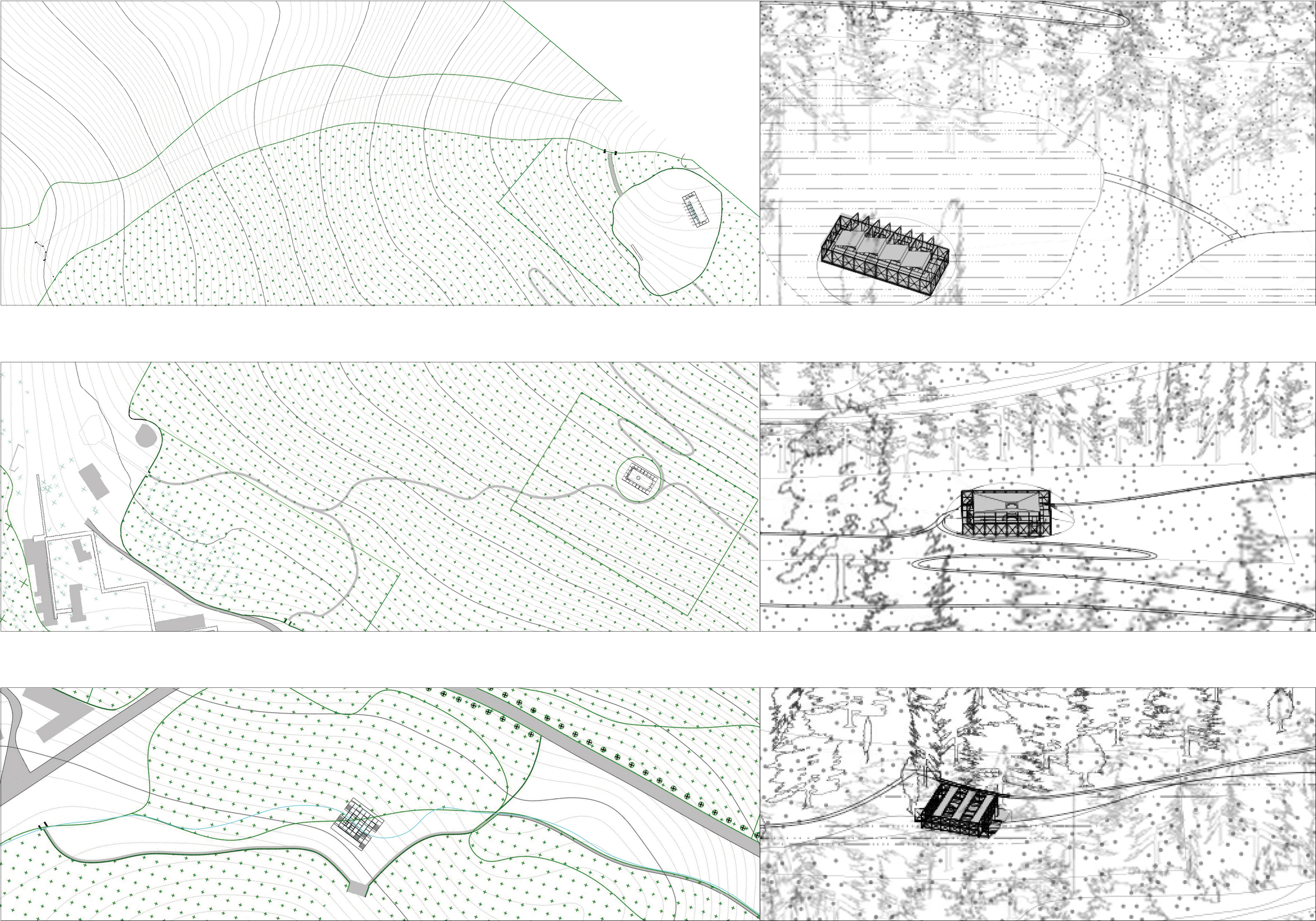

The project expands beyond the current confines of the monastery. New paths link the three nodes anchoring the territory: the monastery complex, the water spring, and the mountaintop.
The edge along the cedar treeline to the east is loose and undefined. Three new gates, a bounding path, and plantings will better define the threshold between the monastery site and the forest.
The edge along the cedar treeline to the east is loose and undefined. Three new gates, a bounding path, and plantings will better define the threshold between the monastery site and the forest.


The gates are understood as embedded or freestanding, through the lens of materiality, functioning as an edge between two conditions, as a “room” to inhabit or a transitory portal to walk through, and in relation to ground and sky.
By proposing a vocabulary of three tent-like pavilions, the project aims to inhabit, but not colonize, the forest. The goal is to make a place to rest and be alone with nature, away from the communal programs in and immediately around the existing buildings.
By proposing a vocabulary of three tent-like pavilions, the project aims to inhabit, but not colonize, the forest. The goal is to make a place to rest and be alone with nature, away from the communal programs in and immediately around the existing buildings.


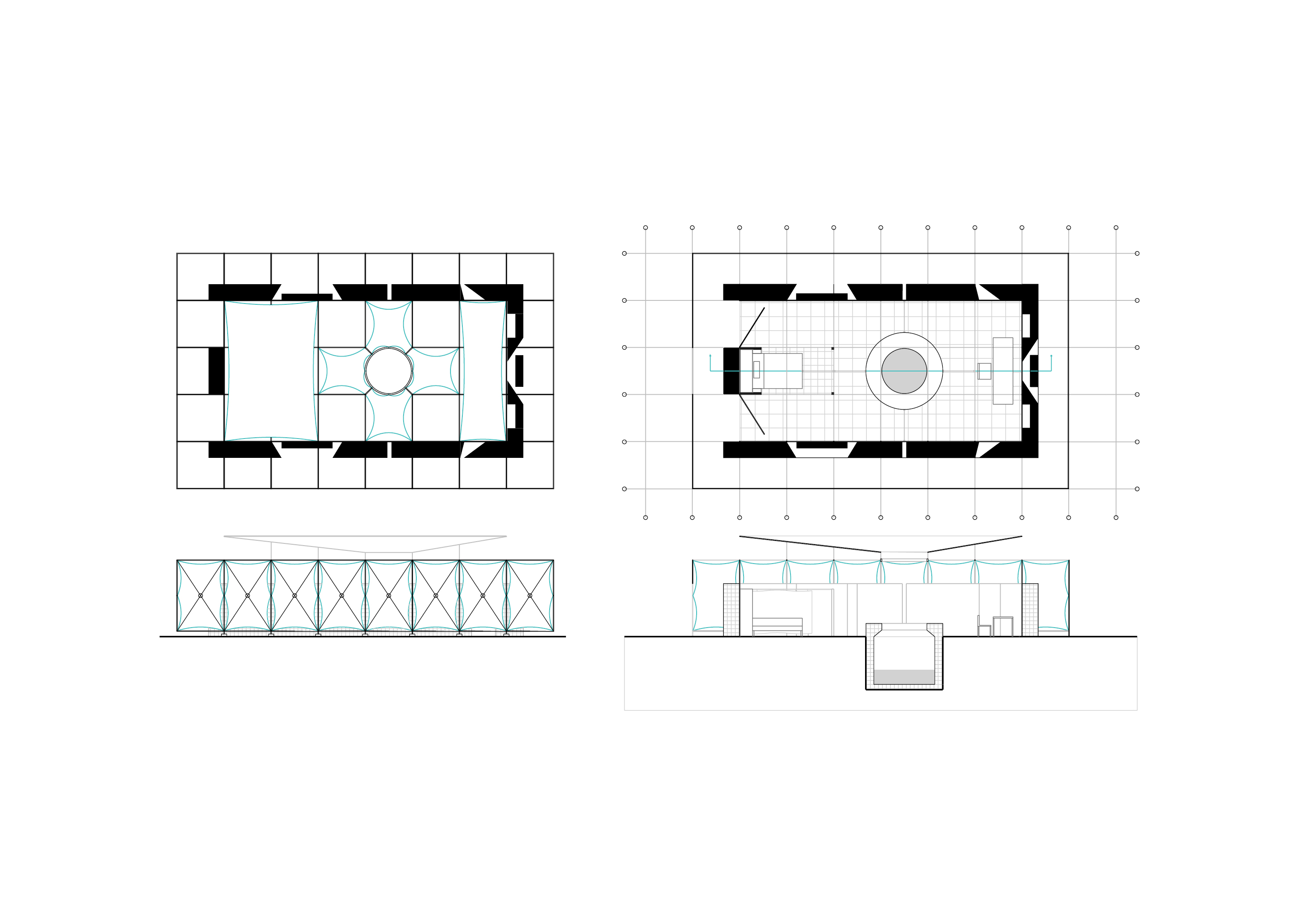
The pavilions are based around a 9’ x 6’ construction module of fabric stretched on a frame.
Within this sheltered realm, masses respond to landscape conditions, chamfering to filter light or accommodating pockets of functionality, mediating ground as retaining walls, or digging into the earth. Objects gesture to the surroundings and sky, enabling spiritual experiences of environment.
Within this sheltered realm, masses respond to landscape conditions, chamfering to filter light or accommodating pockets of functionality, mediating ground as retaining walls, or digging into the earth. Objects gesture to the surroundings and sky, enabling spiritual experiences of environment.




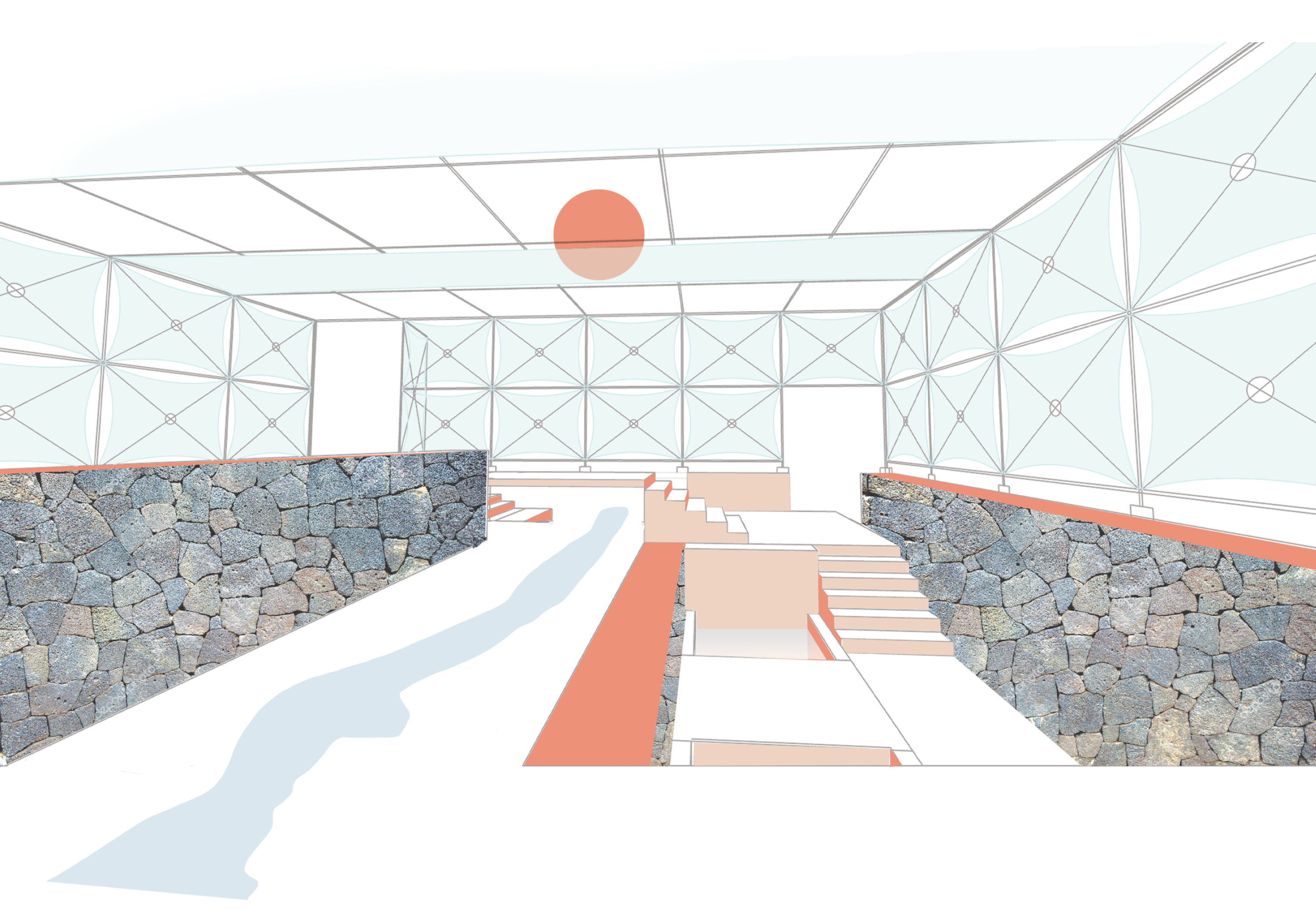

Architecture, as a mediator, can open our eyes to our immediate environment, the world we live in, and the one we hope to create.
Thesis Phases
Bibliography
“Anticolonialism | Global South Studies, U.Va.” Accessed September 16, 2020.
https://globalsouthstudies.as.virginia.edu/key-concepts/anticolonialism.Predating the historical period of decolonization and postcolonial theory, anticolonialism is “both a historical event and a critical analytic.” Whereas the political action was the struggle against extraction and imperial rule in colonized places, the theoretical argument posed hybridity and nostalgia as diametrically opposed, exposed the chasm between European colonial thought and practice, and speculate on what world decolonized nations would inherit.
Ben-Meir, Yossef (2019) "Empowering Rural Participation and Partnerships in Morocco’s Sustainable Development," Journal of Global Initiatives: Policy, Pedagogy, Perspective: Vol. 14 : No. 2 , Article 13.
“Bernard Tschumi Architects.” n.d. Accessed December 13, 2020. http://www.tschumi.com/projects/3/.
Davidson, Cynthia. “Raised to Observe: Glenn Murcutt.” Log, no. 8 (2006): 31–39.In the interview, Murcutt shares his personal philosophy of architecture and sustainability. He argues that speding time immersed in your context, the landscape that you know, is the ethical, sustainable way to design.
Farmer-To-Farmer. n.d. “Farmer-To-Farmer | Home.” Farmer-To-Farmer. Accessed April 6, 2021. https://farmer-to-farmer.org/.
Girot, Christophe. “Recovering Landscape: Essays in Contemporary Landscape Architecture.” Edited by James Corner, 1999.Girot explains the French concept of paysage, a stand-in for my notion of place identity, and provides an interesting provocation built out from his definition, that “There is a deep sense of temporal continuity (both historical and inventive) that pervades the idea of landscape in France.” Temporal continuity, perhaps the equivalent characteristic in landscape to the mutability of a migrant’s status in the land, frames the landscape process as “clustering around issues of memory...landing, grounding, finding and founding.” By identifying the inherent mutability of both land and people as resolved by memory, Girot constitutes a seriously valid point of departure and initial structure for my theoretical framework.
“Global Gender Gap Report 2020.” n.d. World Economic Forum. Accessed April 6, 2021. https://www.weforum.org/reports/gender-gap-2020-report-100-years-pay-equality/.
High Atlas Foundation. 2020. HAF Nursery Tour: Akrich House of Life Fruit Tree Nursery, Tameslouht Commune, Morocco. https://www.youtube.com/watch?v=nyXPH7koJ0M.
———. 2021. HAF Nursery Tour: The Story of Women’s Empowerment in Tassa Ouirgane. https://www.youtube.com/watch?v=qWN0uoHkDDM&t=1s.
“How the Parc de La Villette Kickstarted a New Era for Urban Design.” 2018. ArchDaily. August 10, 2018. https://www.archdaily.com/899597/how-the-parc-de-la-villette-kickstarted-a-new-era-for-urban-design.
Kramarski, G. (2018, September 24). Could Rights-Based Development Encourage Rural Moroccan Women’s Capacity-Building? The Fletcher Forum of World Affairs. http://www.fletcherforum.org/home/2018/9/11/could-rights-based-development-encourage-rural-moroccan-womens-capacity-building
Margolis, Liat, and Aziza Chaouni. 2014. Out of Water - Design Solutions for Arid Regions. Out of Water - Design Solutions for Arid Regions. Birkhäuser. https://www.degruyter.com/document/doi/10.1515/9783038210061/html.
“The Moroccan Family Code ‘Moudawana.’” n.d. EuroMed Rights. Accessed March 20, 2021. https://euromedrights.org/publication/the-moroccan-family-code-moudawana/.
Noury, A. I. (2007, April 5). Lifting Moroccans out of Poverty. Fair Observer. https://www.fairobserver.com/world-news/poverty-morocco-world-news-sustainable-development-34540/
“Reforming Moroccan Family Law: The Moudawana.” n.d. Centre For Public Impact (CPI). Accessed March 20, 2021. https://www.centreforpublicimpact.org/case-study/moroccan-moudawana-reform.
Saint-Exupéry, Antoine de, Lewis Galantière, and John O’Hara Cosgrave. 1939. Wind, sand and stars. New York: Reynal & Hitchcock.This memoir beautifully captured the way that mutability in the land, in this case passing over it in a mail plane, creates nonconformistic, individual interpretations of landscape. Specifically, the ability to constantly exist in a state of landing, as Girot says, creates a unique opportunity to hone ones own reading and process of global landscapes through repeated practice.
“Spotlight: Luis Barragán.” 2020. ArchDaily. March 9, 2020. https://www.archdaily.com/607209/spotlight-luis-barragan.
Tavaana. 2012. “Moudawana: A Peaceful Revolution for Moroccan Women.” Text. Tavaana. August 21, 2012. https://tavaana.org/en/en/content/moudawana-peaceful-revolution-moroccan-women.
United Nations. (2004). The Moroccan Family Code (Moudawana) of February 5, 2004,” Human Rights Education Associates, New York. https://unstats.un.org/unsd/vitalstatkb/Attachment808.aspx?AttachmentType=1
United States Agency for International Development. (2018, June 22). Employability of Youth Enhanced. https://www.usaid.gov/morocco/fact-sheets/employability-youth-enhanced
Additional Resources
“1880 Crow Peace Delegation: Peelatchiwaaxpáash/Medicine Crow (Raven), Peelatchixaaliash/Old Crow (Raven), Iichíilachkash/Long Elk, Déaxitchish/Pretty Eagle, Bia Eélisaash/Large Stomach Woman (Pregnant Woman) Aka Two Belly, Alaxchiiaahush/Many War Achievements or Plenty Coups, Aka Chíilaphuchissaaleesh/Buffalo Bull Facing The Wind.” Accessed September 16, 2020. http://portlandartmuseum.us/mwebcgi/mweb.exe?request=record;id=71459;type=101.Annotations on the portraits provide personal context and situate figures in a narrative of the struggle for honorable treatment by the United States government. Their contemporary nature, scrawled in red pen, marks the archival documents in a graphic, memorable way and clearly delineates the image and the contemporary reading.
Bluestone, Daniel M. Buildings, Landscapes, and Memory: Case Studies in Historic Preservation. W.W. Norton & Company, 2011.Chapters on Court Market Square and detailing the history of prostitution in Charlottesville afford leads or “ways in” to reading the cultural landscape of the region. Both deal with the erased physical cityscapes and histories of the marginalized.
Garber, Megan. “The Dead Dream of the Dirigible.” The Atlantic, May 4, 2012.
https://www.theatlantic.com/technology/archive/2012/05/the-dead-dream-of-the-dirigible/256758/.The article discusses the mutability of public opinion through the lens of air transport technologies, showing the value, utility, and tangible impact of speculative design. The foremost example is that concepts for sky cities manifested in the design of the Empire State Building’s spire.
Garrelts, Bruce Katz, Luise Noring, and Nantke. “Cities and Refugees: The German Experience.” Brookings (blog), September 18, 2016. https://www.brookings.edu/research/cities-and-refugees-the-german-experience/.The arrival of large numbers of refugees into Europe poses a significant humanitarian challenge. The focus on Germany reflects the central role that it is playing in the European refugee crisis: in 2015, 1.1 million refugees crossed the German border; Berlin received nearly 10,000 refugees in November alone, the peak month of that year. German cities are innovating in the delivery of these tasks in the immediate aftermath of the large flows of refugees in 2015.
Horwitz, Tony. Spying on the South: An Odyssey Across the American Divide. Penguin, 2019.The book tells the story of Olmstead’s time as a Connecticut Yankee in the South learning and sharing the culture and society of slavery just before the outbreak of the Civil War, a formative time that created the motivation to create democratic spaces that would push him to become a landscape architect. The theoretical premise, of learning to read Charlottesville as a cultural landscape, derives in large part from this source.
Llewellyn, Robert, and Avery Chenowith. Albemarle: A Story of Landscape and American Identity, 2015. https://www.upress.virginia.edu/title/1096.The book is a photo essay paired with narrative text presenting Albemarle as a cultural landscape, which is what my project seeks to accomplish. It presents a less critical lens, however, and I aim to focus on marginalized groups rather than a dominant narrative.
“Metropolis | Object:Photo | MoMA.” Accessed September 16, 2020. https://www.moma.org/interactives/objectphoto/objects/83984.html.I believe in physically layered chronology as an empowering way of engaging with landscapes that may not require the same prohibitively exclusive level of power and privilege as engaging through a tabula rasa built architectural project. Adaption of structures and landscapes, or even simply leaving an archaeological trace through cultivation or small scale habitation.
“Safe Space -- Gay Neighborhood History and the Politics of Violence.Pdf.” Accessed September 6, 2020. https://collab.its.virginia.edu/access/content/group/71b80249-1167-4e00-9770-780c719b37d4/Safe%20Space%20--%20Gay%20Neighborhood%20History%20and%20the%20Politics%20of%20Violence.pdf.The introduction to this source sets up tensions between queer street youth, often BIPOC, and affluent queer homeowners, often white and partnered, and how the two parties fight for the right to claim public space in Greenwich Village. Its relevance is in the role of community boards and other social organizations in governing public space and upholding the disparity between secure and insecure status individuals.
“Street Kids -- Homeless Youth, Outreach, and Policing New York_s Streets.Pdf.” Accessed September 16, 2020. https://collab.its.virginia.edu/access/content/group/71b80249-1167-4e00-9770-780c719b37d4/Street%20Kids%20--%20Homeless%20Youth%2C%20Outreach%2C%20and%20Policing%20New%20York_s%20Streets.pdf.This source describes how politicians and police collude to define “undesirables” out of the public realm. In the case of New York, efforts to rebrand the city as a family friendly tourist destination meant that queer youth living on the streets had to retreat to the shadows. Youth had to discover new neighborhoods in far flung areas of the city, isolated from social services, and ended up unsafe and dying at higher rates. This is transferable to the project because it demonstrates the kinds of perils marginalized communities in Charlottesville can face when defined out of the public, as in the system of white supremacy and the exploitation of migrant labor.
Issuu. “The Ministry Of Ocean Wisdom.” Accessed November 28, 2020. https://issuu.com/victormoldoveanu/docs/mow_dr.The representation style of this project impressed me. The emphasis on linking oceans with industrial sites and overarching narratives about the environment come together in a compelling way. I respect the speculative nature of the project and how it directs one to consider big questions rather than examine the site itself.
Acknowledgements
Credits
Thank you to thesis critics Kenan Professor of Architecture Karen Van Lengen, FAIA, and Alexander Yuen;
Dr. Yossef Ben Meir, Sofia Ashooh and the High Atlas Foundation;
H.E. Lamia Radi, Moroccan Ambassador to Norway and Iceland, President of Memoires Pour L'Avenir;
Ingrid Hakala, Margaret Walter, and the UVA International Office;
William Stone Weedon Professor Emeritus Reuben M. Rainey, FASLA;
Allison James, Project Manager of Landscape Studies Initiative (LSI), and Merril D. Peterson Professor Beth Meyer, FASLA, Co-Director of the UVA Center for Cultural Landscapes;
Melissa Goldman, Trevor Kemp, and the SARC Fabrication Labs team;
Enrique Cavelier Studio;
Emily Lazaro, Aimee Hunt, Riley McCall, Lisa Reilly, Eleni Andrikou, Anastasia Dakouri-Hild, Steve Davis, Bradley Cantrell, Michael Lee, John Comazzi + Sean Kois, Brooke Ray, Dan Bluestone, Rebecca Coleman, my friends and family, and so many more.
Without your insight, resources, and support, this project would not be possible.
Thank you to thesis critics Kenan Professor of Architecture Karen Van Lengen, FAIA, and Alexander Yuen;
Dr. Yossef Ben Meir, Sofia Ashooh and the High Atlas Foundation;
H.E. Lamia Radi, Moroccan Ambassador to Norway and Iceland, President of Memoires Pour L'Avenir;
Ingrid Hakala, Margaret Walter, and the UVA International Office;
William Stone Weedon Professor Emeritus Reuben M. Rainey, FASLA;
Allison James, Project Manager of Landscape Studies Initiative (LSI), and Merril D. Peterson Professor Beth Meyer, FASLA, Co-Director of the UVA Center for Cultural Landscapes;
Melissa Goldman, Trevor Kemp, and the SARC Fabrication Labs team;
Enrique Cavelier Studio;
Emily Lazaro, Aimee Hunt, Riley McCall, Lisa Reilly, Eleni Andrikou, Anastasia Dakouri-Hild, Steve Davis, Bradley Cantrell, Michael Lee, John Comazzi + Sean Kois, Brooke Ray, Dan Bluestone, Rebecca Coleman, my friends and family, and so many more.
Without your insight, resources, and support, this project would not be possible.

